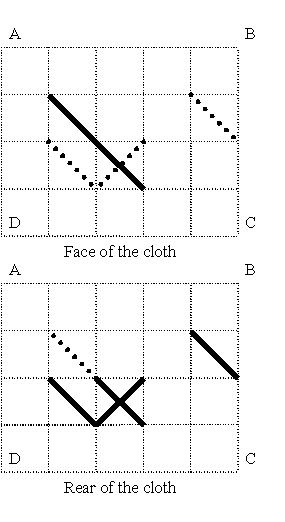当前你的浏览器版本过低,网站已在兼容模式下运行,兼容模式仅提供最小功能支持,网站样式可能显示不正常。
请尽快升级浏览器以体验网站在线编辑、在线运行等功能。
1257:Cross-stitch.
题目描述
Archaeologists have found a cloth decorated with needlework. This needlework is a cross-stitch made with several threads. The following rules have been observed:

This is an example of a pattern made with six stitches. The grid has size 4*5. The face of the cloth is drawn on the upper half of the figure. The stitches lying on the face are drawn with solid lines. The rear stitches uncovered with those of the face are drawn with dot-lines. On the lower half of the figure the cloth is oriented as on the upper half. All the rear stitches are drawn with solid lines there. The face stitches, which do not cover rear stitches, are drawn with dot-lines. It can be seen that there are the stitches at both sides of one of the cell diagonals. This cross-stitch cannot be made with less than four threads.
Archaeologists want to know if the pattern was made with the least number of threads. You have to write a program, which will determine the minimal number of threads needed to make the given pattern.
- The cloth has a grid with square cells.
- Each stitch covers a diagonal of one cell of the grid. Stitches can lie on both sides of the cloth, but each of them lies only at one side of the cloth (the thread can start, finish and cross the cloth only at the grid vertices).
- At most one stitch can lie on each diagonal of each cell at each side of the cloth.
- Each thread makes up several stitches arranged alternately at different sides of the cloth. (It means that two consecutive stitches formed by one thread lay at the different sides of the cloth and are connected in the grid vertex)
- A needle can go through the cloth only in the vertexes of the grid.

This is an example of a pattern made with six stitches. The grid has size 4*5. The face of the cloth is drawn on the upper half of the figure. The stitches lying on the face are drawn with solid lines. The rear stitches uncovered with those of the face are drawn with dot-lines. On the lower half of the figure the cloth is oriented as on the upper half. All the rear stitches are drawn with solid lines there. The face stitches, which do not cover rear stitches, are drawn with dot-lines. It can be seen that there are the stitches at both sides of one of the cell diagonals. This cross-stitch cannot be made with less than four threads.
Archaeologists want to know if the pattern was made with the least number of threads. You have to write a program, which will determine the minimal number of threads needed to make the given pattern.
输入解释
The first line of the input contains two integers N and M separated by a space. They are vertical (N) and horizontal (M) sizes of the grid, i.e. amounts of the cells in a vertical and horizontal rows respectively (1<=N,M<= 200). Each of the following 2*N lines contains M symbols. Each symbol describes one square of the grid. The first N lines correspond to the face of the cloth and the last N lines correspond to the rear of the cloth. The symbols used are ".", "/", "\" and "X" (a dot means an empty square). For more information see the sample. It corresponds to the cloth drawn at the figure.
输出解释
The output should contain one integer — the minimal number of threads needed to make the described pattern.
输入样例
4 5 ..... .\... ..\.. ..... ..... ....\ .\X.. .....
输出样例
4
最后修改于 2020-10-29T05:59:09+00:00 由爬虫自动更新
共提交 0 次
通过率 --%
| 时间上限 | 内存上限 |
| 2000 | 10000 |
登陆或注册以提交代码